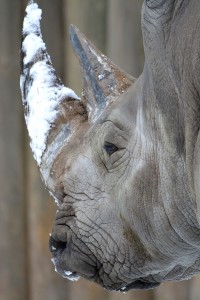As the days get shorter and the temperature drops, Zoo staff start getting exhibits and animals ready for the winter months ahead. Monitoring the animals during the winter leaves us with a whole different set of warning signs to look for.Animals exposed to the elements are in danger of hypothermia, frostbite, and dehydration.
Hypothermia is a condition where animals are unable to create enough body heat to maintain proper temperature. Their internal body temperature begins to drop. Once it drops too low, it is difficult to raise the temperature back to normal. The signs of hypothermia can range from shivering and decreased alertness to more severe such as decreased blood pressure and slow, shallow respiration. If left untreated, hypothermia can be fatal.Frostbite can be seen on the ears, toes, and any other appendages. It can strike any exposed skin. As the temperature drops, the blood flow to these areas decreases. With decreased blood flow, there is decreased circulation and heat moving to the area. The tissue begins to freeze. Signs can include darkening of the skin, pain to the touch, and swelling.
All living things need water. In the winter, finding fresh water can be difficult. Dehydration can occur quickly in animals. Signs can range from weakness to organ failure.
So how do Zoo Keepers prevent these potential problems?
Zoo staff work tirelessly throughout the fall to hang wind breaks, plug in heaters, and add extra bedding. The goal is to have a seamless transition for the animals. All of our animals have access to areas that provide shelter from the wind and snow. This could be in the form of access into a building or a covered area of their enclosure.


For those animals that are more sensitive to the cold, they are provided with as many heaters as are needed to maintain a moderate temperature. Zoo staff monitor the animals daily, and in extreme cold, much more frequently. They watch for signs of shivering, tenderness when walking, and any change in the level of alertness. If any signs are seen, animal health staff are notified immediately and action is taken to prevent any further problems. Any animal housed outside has a heated water bowl to provide access to fresh water at all times.
Animals that live indoors are often given the choice to venture outside for some fresh air. The elephants enjoy eating the snow and typically go out daily for short periods of time. Once the animals are all set for the winter, staff will start pulling out all of their gear to make it through the next few months.
If you are visiting the Zoo this winter, take a moment and thank the keepers for working hard to keep the animals safe and warm!–Robin English, Zoologist








